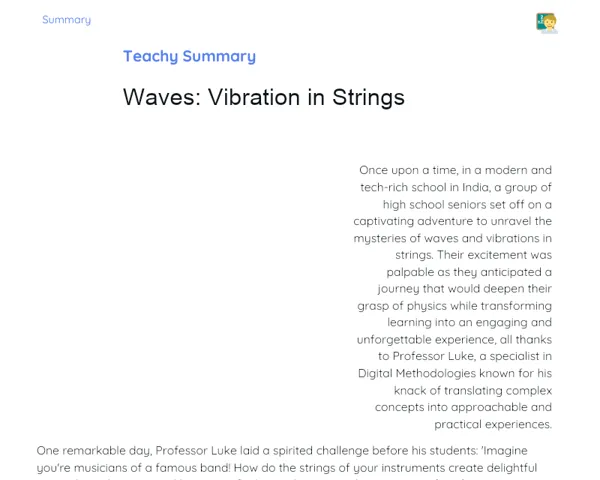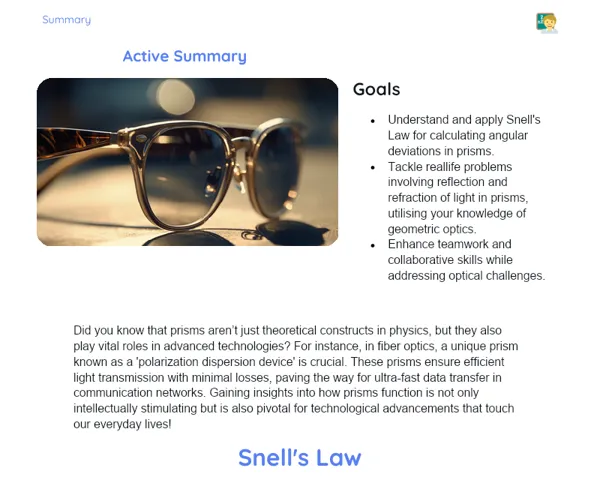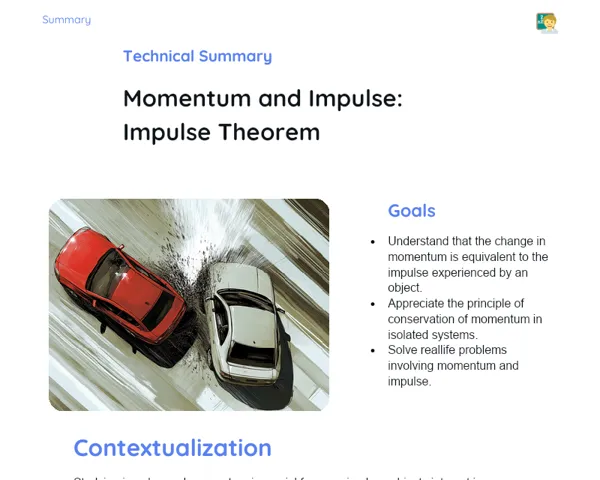Summary Tradisional | Waves: Wave Speed
Contextualization
Waves are all around us, influencing many daily experiences, whether it's the sounds we hear, the light we see, or even the radio and TV signals enabling our communication. Grasping the concept of wave speed is crucial for various technological and scientific fields, including satellite communications, radar technology, and medical applications such as ultrasounds.
Wave speed changes based on the medium through which the waves travel. For instance, sound moves at nearly 343 meters per second in air, while it travels about 1482 meters per second in water. In solids like steel, sound can travel at speeds surpassing 5000 meters per second. These variations are vital for technologies such as sonar in submarines and significantly affect how these systems perform.
To Remember!
Wave Speed Concept
The speed of a wave is determined by the distance it travels over a specified period. This speed is influenced by the medium through which the wave propagates. For instance, the speed of sound differs in air compared to water or steel due to the distinct physical properties of each medium.
In sound waves, the speed is impacted by the medium's density and compressibility. For electromagnetic waves like light, factors such as electric permittivity and magnetic permeability of the medium play a role. A solid understanding of these differences is vital for multiple technological applications, including satellite communication and ultrasonic sensors in the medical field.
Wave speed also holds significance across numerous disciplines such as engineering, physics, and information technology. For instance, in fiber optics, the speed of light is essential for rapid data transmission over the internet. Therefore, understanding how various factors influence wave propagation speed is key to optimizing and developing new technologies.
-
Wave speed changes based on the medium it travels through.
-
The physical attributes of the medium impact wave speed.
-
Wave speed is critically important in various technological applications.
Wave Speed Formula (v = λf)
The formula v = λf links the wave's propagation speed (v) to its wavelength (λ) and frequency (f). Here, 'v' represents the wave speed in meters per second (m/s), 'λ' is the wavelength measured in meters (m), and 'f' is the frequency in hertz (Hz).
This formula is indispensable for calculating the speed of different wave types, whether sound or electromagnetic. For example, determining the frequency and wavelength of a sound wave in air allows us to ascertain its propagation speed, which is essential for understanding phenomena such as room acoustics and sound transmission across various environments.
Furthermore, the formula facilitates examining how changes in frequency or wavelength affect wave speed. For instance, increasing the frequency while decreasing the wavelength may keep the wave speed constant. This relationship is important for many applications, such as transmitting radio and television signals.
-
The formula v = λf connects speed, wavelength, and frequency.
-
Units of measurement include meters per second (m/s) for speed, meters (m) for wavelength, and hertz (Hz) for frequency.
-
The formula applies to different types of waves, including sound and electromagnetic.
Units of Measurement
Using the right units is essential for effectively applying the wave speed formula. Wave speed is measured in meters per second (m/s), wavelength in meters (m), and frequency in hertz (Hz). Maintaining consistency in units when performing calculations is vital to avoid errors.
For example, if wave speed is stated in kilometers per second (km/s), it must be converted to meters per second (m/s) before applying the formula. Similarly, if wavelength is given in centimeters (cm), converting it to meters (m) is necessary for accurate calculations.
Grasping how to use and convert measurement units correctly is crucial not only for physics but also for various scientific and engineering disciplines. Precision in units ensures the accuracy of calculations and the efficiency of practical applications such as equipment calibration and signal transmission.
-
Speed is measured in meters per second (m/s).
-
Wavelength is measured in meters (m).
-
Frequency is measured in hertz (Hz).
-
Consistency in measurement units is of utmost importance.
Influence of External Factors
Wave propagation speed can be influenced by various external factors including temperature, pressure, and the type of medium. For example, sound travels faster in warm air than in cold air, as warm air enables faster movement of its molecules, enhancing sound wave transmission.
Pressure also affects wave speeds. In liquids and solids, the density and elasticity of the material directly influence propagation speed. For electromagnetic waves, the speed of light is primarily affected by the electric permittivity and magnetic permeability of the medium.
Recognizing how these external factors impact wave speed is necessary for practical applications. In medicine, for instance, different body tissues' sound speed is utilized to create ultrasound images. In engineering, the propagation speed of radio waves is a crucial consideration when designing communication systems and radar.
-
External factors like temperature, pressure, and medium type influence wave speed.
-
For instance, an increase in temperature typically increases sound speed in air.
-
Properties like electric permittivity and magnetic permeability are essential for electromagnetic waves.
Key Terms
-
Wave Speed: The distance a wave covers over a specific time period.
-
Wavelength (λ): The distance between two consecutive points on a wave that are in phase.
-
Frequency (f): The number of oscillations or cycles of a wave within a unit time.
-
Formula v = λf: Describes the connection between speed, wavelength, and frequency.
-
Units of Measurement: Speed in meters per second (m/s), wavelength in meters (m), and frequency in hertz (Hz).
-
Sound Waves: Mechanical waves that move through material media such as air, water, and solids.
-
Electromagnetic Waves: Waves that can travel without a material medium, such as light and radio waves.
Important Conclusions
In this lesson, we examined wave propagation speed, a fundamental concept applicable across various scientific and technological fields. We discussed the v = λf formula, which connects a wave's speed to its wavelength and frequency, while underscoring the significance of accurate measurement units. Additionally, we examined how external factors, such as temperature and pressure, can impact wave propagation speed across diverse media.
A solid understanding of these concepts is vital for practical applications like satellite communications, ultrasound in medicine, and engineering applications in radar and sonar systems. Being able to calculate speed, wavelength, and frequency is crucial for optimizing the technologies we interact with daily, from the internet to radio and TV broadcasts.
We encourage students to further explore this topic as the field of wave propagation is vast and full of practical uses. A deeper knowledge of these concepts can lead to technological advancements and enhance our understanding of the natural phenomena that surround us.
Study Tips
-
Review the v = λf formula and practice calculations using different values for wavelength and frequency to solidify your understanding.
-
Explore how wave speeds change across various media and conditions like temperature and pressure to appreciate their practical implications.
-
Utilize additional educational resources, such as videos and online simulations, to visualize wave propagation and its technological impacts.



